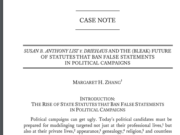In a lengthy press release posted earlier this week, Democracy 21 President Fred Wertheimer argues that one should “question the openness and candor” of Chief Justice John Roberts’s opinion in McCutcheon v. FEC. In holding that “corruption,” as that term was used in the 1976 decision of Buckley v. Valeo, must be limited to quid-pro-quo transactions, the Chief Justice “dissembles, obfuscates, and misleads.”
Even by the low standards of the present national debate on campaign finance, this is a remarkable claim. Put simply, Mr. Wertheimer argues that the Supreme Court’s majority isn’t simply wrong. It is dishonest as well.
Mr. Wertheimer, unsurprisingly, provides no direct evidence of the Court’s duplicity.
Consequently, his argument can be summarized: because no one can possibly believe that Buckley meant what the Chief Justice says it did, his reading must be dishonest. The retort is obvious: if anyone could reasonably agree with the Chief Justice, there is little ground for “questioning [his] openness and candor.”
Can a reasonable person agree with the Chief Justice?
Here is what he said:
Any regulation must … target what we have called “quid pro quo” corruption or its appearance. That Latin phrase captures the notion of a direct exchange of an official act for money. The hallmark of corruption is the financial quid pro quo: dollars for political favors. Campaign finance restrictions that pursue other objectives, we have explained, impermissibly inject the Government into the debate over who should govern. And those who govern should be the last people to help decide who should govern.
That is the essence of the debate. Is the government targeting “corruption,” or is it actually trying to do something else—“level the playing field,” or “level electoral opportunities,” or “equalize the financial resources of candidates”—while labeling its effort as combating corruption? When the Court’s majority says “the hallmark of corruption is the financial quid pro quo,” Mr. Wertheimer argues that it is intentionally misreading past decisions.
In McCutcheon, the Chief Justice explicitly roots this quid-pro-quo reading of corruption “in Buckley itself.” His opinion is understandable, and entirely reasonable, if one looks to the entire opinion and not merely to the out-of-context quotations Mr. Wertheimer provides.
Buckley v. Valeo
Buckley began its analysis by defining the government’s interest as “the prevention of corruption and the appearance of corruption spawned by the real or imagined coercive influence of large financial contributions on candidates’ positions and on their actions if elected to office.” Notice two things. First, the danger cited in Buckley isn’t generic influence, as Mr. Wertheimer might argue. Rather, it is coercive influence. Second, the thing that may be coerced is the “candidates’ positions… and actions.”
This certainly doesn’t settle the debate, but the Buckley Court devotes two paragraphs to explaining itself. Tracking its finding that the governmental interest is “the prevention of corruption and the appearance of corruption,” the Court spends one paragraph explaining each.
First, regarding its understanding of “corruption,” the Court imagines “a candidate lacking immense personal or family wealth [who] must depend on financial contributions from others to provide the resources necessary to conduct a successful campaign.” In such cases, where fundraising is “an essential ingredient of an effective candidacy,” there may be a risk of coercion. But this is true only “to the extent that large contributions are given to secure a political quid pro quo from current and potential office holders…” (emphasis supplied).
Second, the Court notes that a danger is also posed by “the appearance of corruption stemming from public awareness of the opportunities for abuse inherent in a regime of large individual financial contributions.” But the opinion explicitly contrasts this language with “the danger of actual quid pro quo arrangements” described in the previous paragraph. This strongly suggests two things. First, that “actual quid pro quo arrangements” are the “corruption” prong of “corruption and the appearance of corruption” mentioned two paragraphs earlier. Second, that the “appearance of corruption” and “opportunities for abuse” it is discussing here are opportunities for the same quid-pro-quo exchanges posed by the candidate of modest means mentioned earlier. That is to say, the opinion is referencing the appearance that such exchanges might have taken place, even if they cannot be proven.
At this point, the Buckley court has already used the term “quid pro quo” twice to describe corruption. It has said that the danger posed by contributions to a needy candidate is real, but only to the extent it results in a quid pro quo transaction. And it has contrasted the “appearance of corruption” to “actual quid pro quo arrangements.” Perhaps that is enough to excuse the Chief Justice from charges of bad faith.
Mr. Wertheimer’s Examples
Mr. Wertheimer disagrees. He believes that “in direct conflict with Chief Justice Robert’s [sic] misleading claim in McCutcheon, the Supreme Court in Buckley explicitly rejected a constitutional justification for contribution limits limited only to quid pro quo corruption, or ‘bribery.’” His reasoning comes from the following passage in Buckley:
Appellants contend that the contribution limitations must be invalidated because bribery laws and narrowly drawn disclosure requirements constitute a less restrictive means of dealing with ‘proven and suspected quid pro quo arrangements.’ But laws making criminal the giving and taking of bribes deal with only the most blatant and specific attempts of those with money to influence governmental action.
Notice that the Court does not reject the “quid pro quo arrangements” standard, despite having the opportunity to do so. Rather, it says that bribery laws do not cover the universe of quid pro quo arrangements, and are insufficient to prevent the appearance of such arrangements. This makes sense: criminal bribery laws require proof beyond a reasonable doubt, and may not encompass campaign contributions to a political committee (as opposed to money given directly to a candidate in his personal capacity). That it chose to use the phrase “to influence governmental action” may just reflect a desire not to use the phrase “quid pro quo” in every sentence of the opinion, having already established what “corruption” means, and that when it says “influence” it means “coercive influence.”
Mr. Wertheimer goes on to note a passage where the Buckley court states that “Congress was surely entitled to conclude that disclosure was only a partial measure, and that contribution ceilings were a necessary legislative concomitant to deal with the reality or appearance of corruption inherent in a system permitting unlimited financial contributions.”
But here we are discussing the base contribution limits—the amount of money that can be given to the poor Congressional candidate mentioned earlier in the opinion—not aggregate limits on how much may be contributed to his colleagues. And as already noted, when discussing that candidate, the Court used the language of quid pro quo corruption.
Moreover, saying that this disproves a quid pro quo standard makes no sense. The phrase is not defined in this passage. The Court had already discussed corruption; invoking it here invokes that conversation. Mr. Wertheimer seems to believe that whatever happens to be “inherent in a system of unlimited contributions” is itself corruption, a construction that the Court cannot possibly have intended. It is far more likely that the Court is echoing its earlier concern that the appearance of corruption “stem[s] from public awareness of the opportunities for abuse inherent in a regime of large individual financial contributions.” The parallel language is striking. And we have already noted that the first instance of that language was in contrast with “quid pro quo arrangements.”
Finally, Mr. Wertheimer quotes Buckley’s finding that “Congress could legitimately conclude that the avoidance of the appearance of improper influence is also critical.” This sentence appears at the end of the paragraph invoking “actual quid pro quo arrangements” and contrasting them with the “the appearance of corruption.” It is likely that the phrase “improper influence” is intended to invoke the quid pro quo language a mere two sentences earlier.
Mr. Wertheimer quotes from a number of other Supreme Court opinions. It is possible that he reads those sections correctly; Chief Justice Roberts explicitly noted (quoting Justice Stevens’s dissent in Citizens United) that the Court “ha[s] not always spoken about corruption in a clear or consistent voice.” But since he pins his claims of bad faith upon the Chief Justice’s reading of Buckley, and since it is Buckley that created the “corruption and its appearance” standard in the first place, I believe it sufficient to meet him on that point.
Evidence of Bad Faith?
Buckley is well over 100 pages long. Few attorneys, let alone journalists or members of the public, have read it. It is a complex and, at times, mystifying document. To argue that it can only be read in one way is belied by the fact that members of the Supreme Court read it in such disparate ways. Mr. Wertheimer does the public a disservice in declining to acknowledge that this area of the law is complex and that reasonable people can and do disagree when interpreting it.
Mr. Wertheimer is entitled to his opinion of both Buckley and McCutcheon. But his claims of bad faith and duplicity are poorly defended. As I note above, there is indeed a good faith basis for the Chief Justice—and four other members of the Supreme Court—to believe that the “corruption” referred to in Buckley is limited to quid pro quo corruption.
The great irony, of course, is that Mr. Wertheimer is concerned that “the perception that partisan politics has infected the court’s work may do lasting damage to its prestige and authority and to Americans’ faith in the rule of law.” Perhaps he should consider whether blast press releases, claiming that a decision of the majority of the Court cannot possibly be justified on the law when it fact it can, is itself part of the problem. Perhaps Americans would have greater “faith in the rule of law” if Mr. Wertheimer and others were not attempting, explicitly, to delegitimize decisions of our nation’s highest court by imputing dishonesty to good-faith disagreement.














